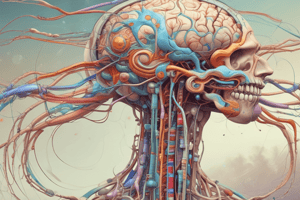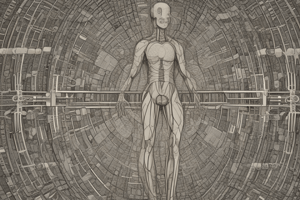Podcast
Questions and Answers
Which statement is true regarding the innervation of the iris muscles?
Which statement is true regarding the innervation of the iris muscles?
- Iris sphincter muscle is supplied by the sympathetic division.
- Iris dilator muscle is not innervated by the ANS.
- Iris sphincter muscle is supplied by the parasympathetic division. (correct)
- Iris dilator muscle is supplied by the parasympathetic division.
Which of the following structures is supplied by the sympathetic division of the ANS but through parasympathetic receptors?
Which of the following structures is supplied by the sympathetic division of the ANS but through parasympathetic receptors?
- Iris sphincter muscle
- Thermoregulatory sweat glands (correct)
- Blood vessels
- Arrector pili muscle
What is the consequence of a fall in blood pressure according to the reflex arc described?
What is the consequence of a fall in blood pressure according to the reflex arc described?
- Increased sympathetic output and decreased parasympathetic output. (correct)
- Increased parasympathetic output and decreased sympathetic output.
- Increased parasympathetic output to the heart and vasculature.
- Decreased sympathetic output to the heart and vasculature.
Study Notes
Autonomic Nervous System (ANS) Innervation
- Most organs in the body receive dual innervation from both divisions of the ANS.
- Some organs, however, are supplied by only one division of the ANS:
- Iris sphincter muscle (circular) is supplied by parasympathetic fibers (M3).
- Iris dilator muscle (radial) is supplied by sympathetic fibers (a1).
- Arrector pili muscle (pilomotor muscle) is supplied by sympathetic fibers (a1), causing involuntary hair erection in response to stress, cold, or fear.
- Thermoregulatory (eccrine) sweat glands are supplied only by sympathetic fibers, but through cholinergic (parasympathetic) receptors (M3).
- Blood vessels: vascular smooth muscle is primarily innervated by the sympathetic, with indirect non-innervation by the parasympathetic.
Central Nervous System (CNS) in Autonomic Function
- The ANS is controlled by streams of afferent impulses originating in the viscera and other autonomically innervated structures.
- These impulses travel to integrating centers in the CNS, such as the hypothalamus, medulla oblongata, and spinal cord.
- The CNS responds to stimuli by sending out efferent reflex impulses via the ANS.
Reflex Arc
- A reflex arc is a neural pathway controlling an action reflex.
- Most afferent impulses are involuntarily translated into reflex responses.
- Example: a fall in blood pressure triggers a reflex response, increasing sympathetic output to the heart and vasculature, and decreasing parasympathetic output to the heart, resulting in a compensatory rise in blood pressure and tachycardia.
Studying That Suits You
Use AI to generate personalized quizzes and flashcards to suit your learning preferences.
Description
Learn about the dual innervation of organs by the ANS and exceptions with single division supply, including iris and arrector pili muscles.



